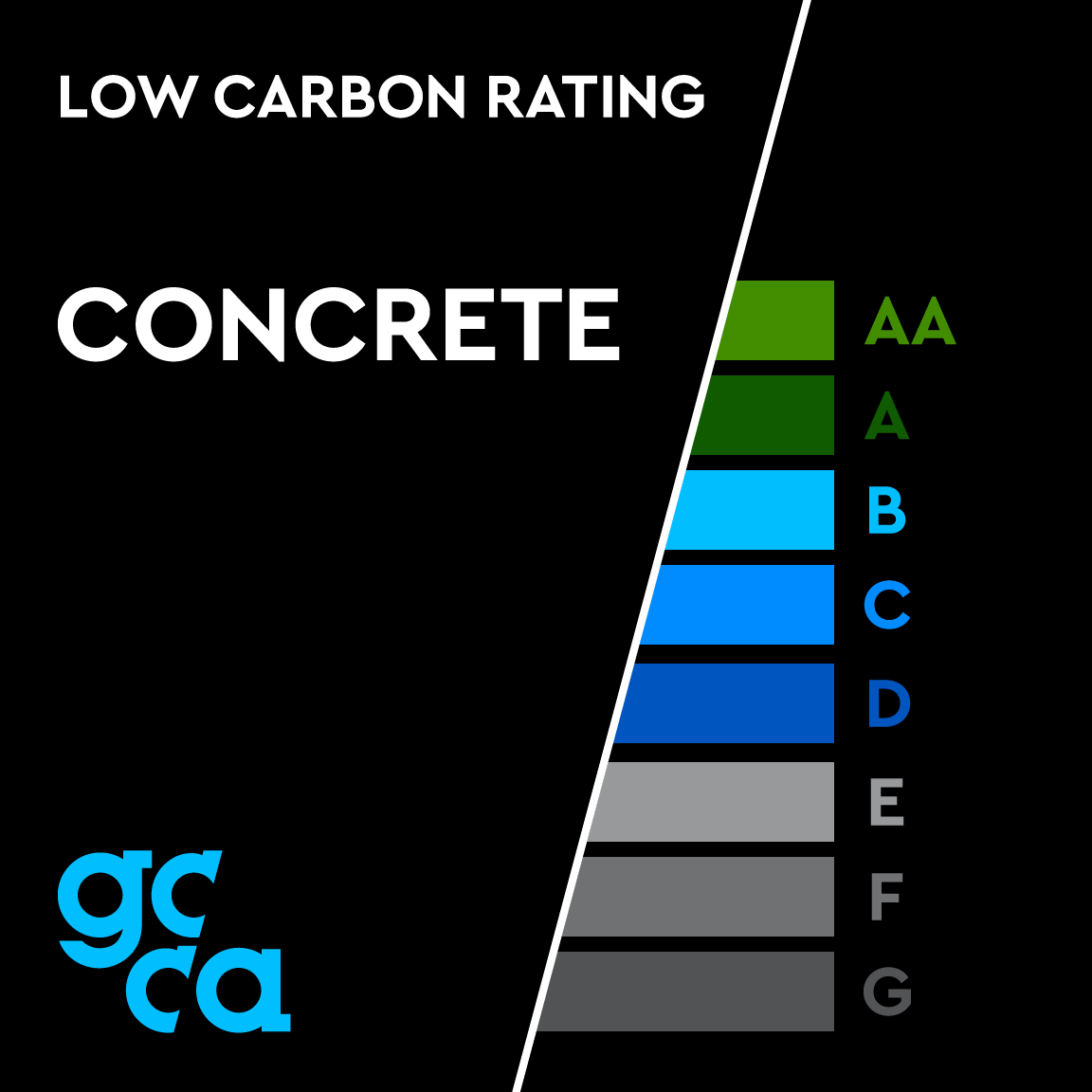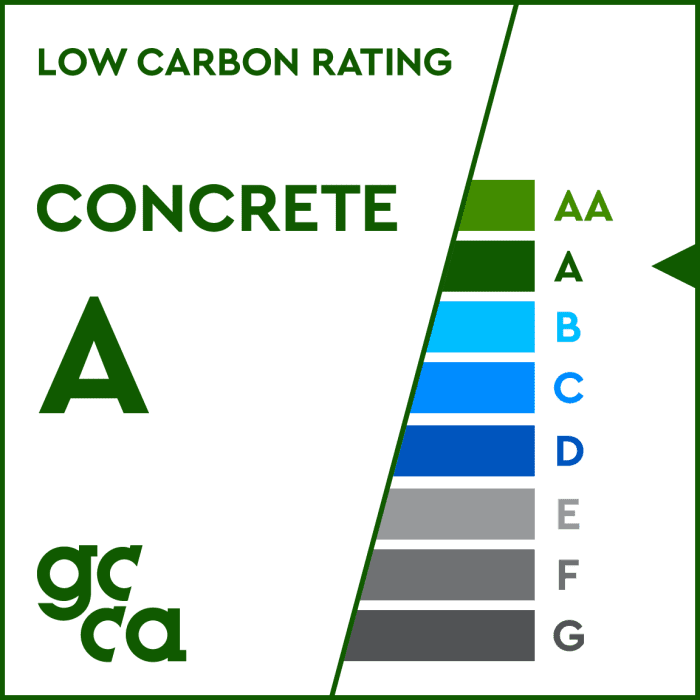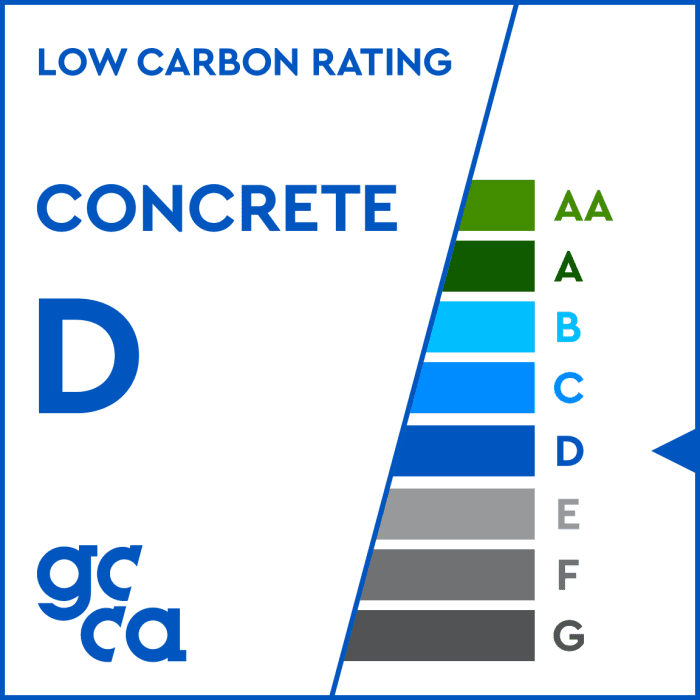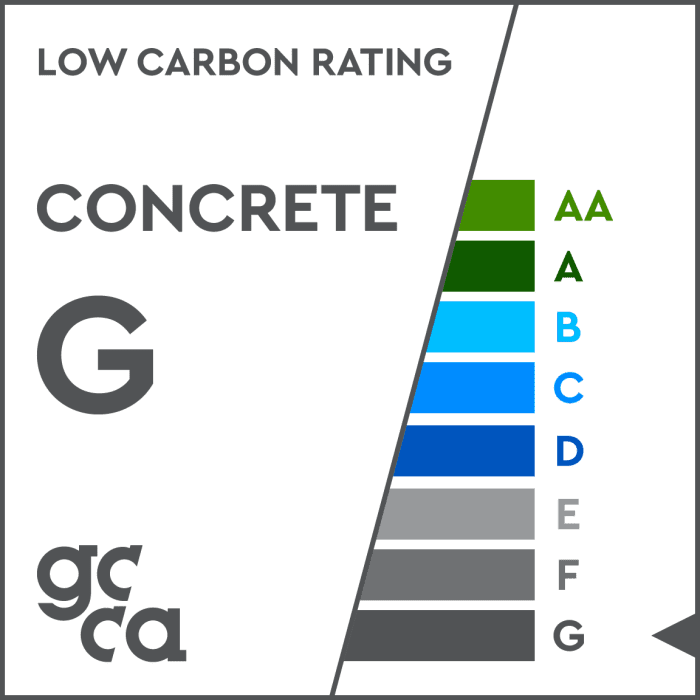The GCCA Global Ratings for Concrete are the implementation of the numerical definitions introduced by the GCCA at COP29 in November 2024, and categorise concrete products based on their Global Warming Potential (GWP), measured in embodied carbon dioxide equivalent per cubic metre (ECO₂e/m³).
Ratings – description
The GCCA low carbon concrete ratings system has the criteria of GWP (kg CO₂e/m³) and concrete strength (MPa). This is because higher-strength concrete generally requires more cement and hence has a higher carbon footprint. Users select the concrete strength for their specified or manufactured product, and can read the relevant ratings from graphical and tabulated presentation


There are 8 ratings (AA to F):
| Rating | Description |
|---|---|
| AA | Near Zero Emissions Concrete – builds on the International Energy Agency’s near-zero definition for cement and the GCCA global roadmap to 2050 for efficiency of cement in concrete and fully decarbonised electrical grid and transport system |
| A – F | Equally spaced carbon footprint values define the ratings |

| Specified Concrete Cylinder Strength (MPa) | ||||||
|---|---|---|---|---|---|---|
| 20 | 25 | 30 | 35 | 40 | 50 | |
| Top of F | 302 | 335 | 372 | 418 | 450 | 500 |
| Top of E | 255 | 283 | 314 | 353 | 380 | 422 |
| Top of D | 208 | 231 | 256 | 288 | 310 | 345 |
| Top of C | 161 | 179 | 199 | 224 | 241 | 268 |
| Top of B | 115 | 127 | 141 | 159 | 171 | 190 |
| Top of A | 68 | 75 | 83 | 94 | 101 | 113 |
| Top of AA – Near Zero Product | 21 | 23 | 26 | 29 | 32 | 36 |
Ratings – derivation
The ratings are based on:
- Good practice cement products
- Good practice concrete mix designs to lower emissions
- Industry data from major cement-producing countries
The ratings are the implementation of the numerical definitions introduced by the GCCA in COP 29 in November 2024.
These ratings provide a clear, globally consistent way to classify concrete based on carbon emissions.
Key Features & Benefits
- Ready for Adoption: A rating scheme that can be readily adopted, and adapted if needed, saving time and effort.
- Standardised Measurement: Uses Environmental Product Declarations (EPD), as a common reporting mechanism for evaluating the carbon footprint of concrete.
- Supports Multilateral Government Initiatives: Designed to align with Clean Energy Ministerial Industrial Deep Decarbonisation Initiative (IDDI) and builds on a starting point of IEA definitions.
- Allows for Country Adaptation: While the GCCA ratings are global, they allow for local adaptation, recognising that EPD practise and custom in a country may differ from the global norm.
- Global Comparability: Enables carbon footprint comparison of concrete products through globally consistent ratings, even when country adaptation has been required/implemented to recognise local EPD practise and custom.
Purpose and Applications
- Procurement: Provides clients and governments a globally recognised rating system to underpin low carbon procurement – a system which is designed to be overlaid with local current average values and targets
- Reporting: Allows organisations (supply or demand) to report and track progress on carbon footprint of products in a globally consistent manner
- Comparability: Enables comparison of concrete products, including across different countries – For example, a “D” rating in, for example, Canada means the same level of carbon performance as a “D” rating in, for example, Thailand, even if the ECO₂e/m³ value differs due to local EPD standards and practise
Rating a product
To determine a product’s rating:
- A manufacturer calculates the product GWP in accordance with EPD methodology
- GWP is compared with GCCA global rating graph
To compare against the ratings the GWP of the concrete product first needs to be calculated according to the EPD methodology , and more specifically:
- Standards: EN 15804+A2, PCR-001 – Cement and building lime (EN 16908) a
- Database: ecoinvent
- Scope: cradle-to-gate (A1-A3)
- “Net GWP”: Emissions from treated waste accounting as per ISO 21930 and EN 15804+A2 (some countries, contrary to the standards, choose to account for emissions from treated waste and report gross GWP)
A type-III EPD is by definition a third party verified document, meaning that a producer can simply rate their products based on the GWP value.








EPD methodology / Country adaptation
The GCCA ratings use the following EPD methodology, the most widely used globally:
- Standards: EN 15804+A2, PCR-001 – Cement and building lime (EN 16908) a
- Database: ecoinvent
- Scope: cradle-to-gate (A1-A3)
- “Net GWP”: Emissions from treated waste accounting as per ISO 21930 and EN 15804+A2 (some countries, contrary to the standards, choose to account for emissions from treated waste and report gross GWP)
If a country has different EPD custom and practice GCCA has already, or will, work with the national association to develop national adapted ratings. Manufacturers can then calculate GWP using the country EPD custom and practice.
To compare against the ratings the GWP of the concrete product first needs to be calculated according to the EPD methodology described earlier.
Country adaption example
Whilst the GCCA ratings can be readily adopted by most countries, they allow for country adaptation in cases where local standards and custom differ.
The UK has adopted the GCCA global ratings while making adjustments to reflect:
- UK-specific EPD reporting: Uses “gross” rather than “net” emissions for waste-derived fuels.
- Concrete strength notation: Includes both cylinder and cube strength for clarity.
- Extended strength ranges to suit UK industry needs.
This ensures that the UK remains aligned with global standards while maintaining national comparability.